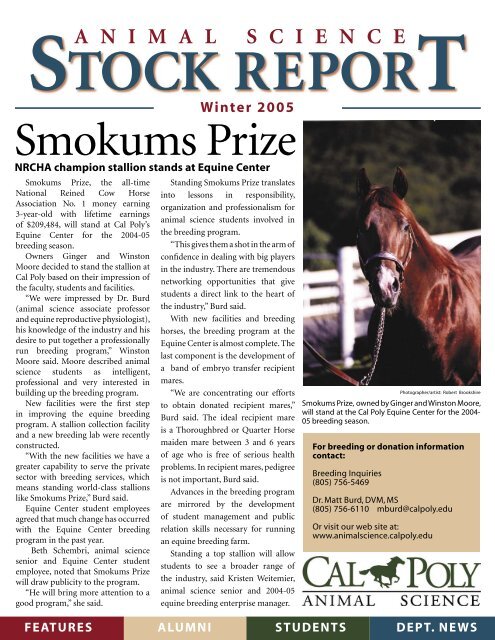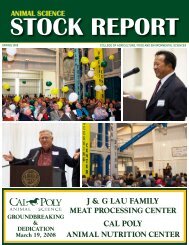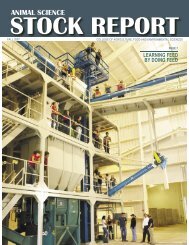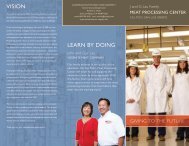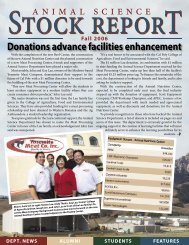Winter 2005 - Animal Science Department - Cal Poly San Luis Obispo
Winter 2005 - Animal Science Department - Cal Poly San Luis Obispo
Winter 2005 - Animal Science Department - Cal Poly San Luis Obispo
- No tags were found...
Create successful ePaper yourself
Turn your PDF publications into a flip-book with our unique Google optimized e-Paper software.
A N I M A LSTOCK REPORTS C I E N C E<strong>Winter</strong> <strong>2005</strong>Smokums PrizeNRCHA champion stallion stands at Equine CenterSmokums Prize, the all-timeNational Reined Cow HorseAssociation No. 1 money earning3-year-old with lifetime earningsof $209,484, will stand at <strong>Cal</strong> <strong>Poly</strong>’sEquine Center for the 2004-05breeding season.Owners Ginger and WinstonMoore decided to stand the stallion at<strong>Cal</strong> <strong>Poly</strong> based on their impression ofthe faculty, students and facilities.“We were impressed by Dr. Burd(animal science associate professorand equine reproductive physiologist),his knowledge of the industry and hisdesire to put together a professionallyrun breeding program,” WinstonMoore said. Moore described animalscience students as intelligent,professional and very interested inbuilding up the breeding program.New facilities were the first stepin improving the equine breedingprogram. A stallion collection facilityand a new breeding lab were recentlyconstructed.“With the new facilities we have agreater capability to serve the privatesector with breeding services, whichmeans standing world-class stallionslike Smokums Prize,” Burd said.Equine Center student employeesagreed that much change has occurredwith the Equine Center breedingprogram in the past year.Beth Schembri, animal sciencesenior and Equine Center studentemployee, noted that Smokums Prizewill draw publicity to the program.“He will bring more attention to agood program,” she said.Standing Smokums Prize translatesinto lessons in responsibility,organization and professionalism foranimal science students involved inthe breeding program.“This gives them a shot in the arm ofconfidence in dealing with big playersin the industry. There are tremendousnetworking opportunities that givestudents a direct link to the heart ofthe industry,” Burd said.With new facilities and breedinghorses, the breeding program at theEquine Center is almost complete. Thelast component is the development ofa band of embryo transfer recipientmares.“We are concentrating our effortsto obtain donated recipient mares,”Burd said. The ideal recipient mareis a Thoroughbred or Quarter Horsemaiden mare between 3 and 6 yearsof age who is free of serious healthproblems. In recipient mares, pedigreeis not important, Burd said.Advances in the breeding programare mirrored by the developmentof student management and publicrelation skills necessary for runningan equine breeding farm.Standing a top stallion will allowstudents to see a broader range ofthe industry, said Kristen Weitemier,animal science senior and 2004-05equine breeding enterprise manager.Photographer/artist: Robert BrookshireSmokums Prize, owned by Ginger and Winston Moore,will stand at the <strong>Cal</strong> <strong>Poly</strong> Equine Center for the 2004-05 breeding season.For breeding or donation informationcontact:Breeding Inquiries(805) 756-5469Dr. Matt Burd, DVM, MS(805) 756-6110 mburd@calpoly.eduOr visit our web site at:www.animalscience.calpoly.eduFEATURES ALUMNI STUDENTS DEPT. NEWS
ASCI 403: techniques, experience and the alphabet of biotechal <strong>Poly</strong> animal science studentshave an opportunity to experiencewhat few animal science studentswill encounter at other universities.ASCI 403, applied biotechnology inanimal science, is a course that teachesthe techniques and methodologies usedin animal research and biotechnology.This includes experimental design, modelassessment, and data interpretation appliedin an experimental setting.“ASCI 403 gives students a hands onapproach to current techniques appliedin production systems as well as research,”said Garret Guenther, an animal sciencesenior and teacher’s assistant for thecourse.He explained that students who take thiscourse will have a tremendous advantageto those who are not educated about theseprinciples.Furthermore, Guenther pointed outthat students in all fields of animal sciencewill benefit from the class. “This courseapplies to every animal science studentfrom animal production to veterinarymedicine, to research,” he said.Kory Alderson, a teacher’sassistant for ASCI 403, saidthe course gave her technicalskills that are usually learnedon a graduate level, but moreimportantly she can go intograduate school knowing whatshe is getting into.When Alderson visitedgraduate programs she saidshe realized the class puther one step ahead of otherapplicants.“Graduate professors at(University of <strong>Cal</strong>ifornia)Davis were amazed by theexperience the class has givenme,” Alderson said.The construction of a biotechnologylab allowed the course to exist, but it isthe teaching methods of animal scienceprofessor Dan Peterson that opens theworld of biotechnology to <strong>Cal</strong> <strong>Poly</strong>students.Guenther said Peterson keeps the classinteresting by using analogies, “while stillmaking it easy to understand.”Peterson explains that understandingbiotechnology is like to learning to read.He tells his class that learning the alphabetis pretty boring, but reading is impossibleif you don’t know the alphabet.“Dr. Peterson does a very good jobteaching the alphabet of biotechnology inthis course using his exceptional knowledgeof the sciences as well as his quirky senseof humor,” Alderson said.Even though the biotechnology lab isadvanced, it is not free of complications.“Things don’t always go they way you(expect) and you don’t always have theresources you’d like, but the solution is notto throw up your hands and give up. Youhave to learn to be innovative and adaptin order to be successful in the real world,”Peterson said.The class is designed as a practical andexperiment-based class where students getexposure to real decisions that have to bemade. Peterson said he wants students tocome away from the course with a confidencein their ability to solve problems.“Everything is possible; it’s just a matterof how you go about pursuing it,” Petersonsaid.Left: A student loads a polyacrylamide gel toseparate cellular proteins for identification.Above: Students pipet cell culture media inthe ASCI 403 lab.2 www.animalscience.calpoly.edu
T h e V i s i o n C o n t i n u e sDuring the past five years, we have workedtoward a major department goal to remodel,enhance and construct new animal scienceteaching facilities so that we may send our studentsinto the professional world with the exceptional“Learn-by-Doing” education that <strong>Cal</strong> <strong>Poly</strong> pridesitself in providing.Last year, the university announced that severalCarol Rose and former <strong>Department</strong> Head Richard Johnson<strong>Animal</strong> science faculty retire after decades of serviceThe past two years saw the retirement of animal science department faculty who were conerstones of their respective programs. Theirinfluence resonates through the department as they impacted the lives of many students, faculty and staff.Robert VanceRobert Vance retiredin September 2003 afterspending more than threedecades with <strong>Cal</strong> <strong>Poly</strong>.Vance served as the Food<strong>Science</strong> and Nutritiondepartment head from1978 to 1988, where hebuilt the department intoone of the largest and strongest undergraduate food science programsin the country. He spent the last four years with the animal sciencedepartment. <strong>Animal</strong> science students scored his teaching abilities asone of the highest in the department. Vance received the 2002-03College of Agriculture’s Sustained Excellence in Teaching Award.“Robert has (had) a profound influence on many young people,as they have chosen the meat industry for meaningful employment.He stimulated students to develop an interest in science, as a result,several former students achieved advanced degrees and have becomeleaders in the meat industry,” said Andy Thulin, animal sciencedepartment head.Roger HuntRoger Hunt spent 26 years asan animal science professor andequine specialist at <strong>Cal</strong> <strong>Poly</strong>. Heretired in June 2004. He servedas the Horse Unit manager from1980 to 1990.During his timeas manager andprofessor hemade significantimprovements tothe Horse Unitfacilitiesimprovedof the animal science facilities would need to berelocated in order to build a much needed studenthousing complex on campus. While the departmenthas made great progress over the past five years,we realize that we must now aggressively pursueprivate funding to compensate for limited statemonies to fund the relocation of the beef center,feed mill, meat processing and beef feedlot. Manyof the department’s facilities that were builtnearly 50 years ago need major improvementsto meet current USDA, FDA, OSHA and otherstandards. The relocation of animal scienceunits will provide the department with a greatopportunity to build new, more technologicallyadvanced facilities.Our students and alumni continue to shine fortheir accomplishments throughout the country.This issue of the Stock Report highlights someof these achievements including senior projects,research work and enterprise successes. Thisthatthe“safety for the students and horses at the unit. Hunt added a teasingcorral, a six -horse barn, pipe fencing around the Hadley Arena andremodeled the breeding barn twice, among others in a long list offacility improvements. Hunt and former Horse Unit manager andanimal science professor emeritus, Robert Hadley, introducedartificial insemination to the equine breeding program.Hunt accepted the golden handshake early retirement packageoffered by the State of <strong>Cal</strong>ifornia in order to take care of his mother.He also works toward building up his own horse facilities, at hishome in Paso Robles, where he holds horsemanship clinics.“Change is good,” Hunt said. “I’m still very excited about <strong>Cal</strong><strong>Poly</strong>, their philosophy and program. Dr. Burd will provide a lot ofopportunity for students. I’m excited for them.”Mike LundMike Lund retired duringSummer 2004 with his acceptanceof the golden handshake earlyretirement package offered by theState of <strong>Cal</strong>ifornia. He joined theanimal science department facultyin 1984.Lund returned for the 2004academic year to teach part time. Heteaches training and riding courses.Lund was the equine breedingmanager through 2003. He was also adviser to the Quarter HorseEnterprise and the Ranch Horse Enterprise. With retirement, Lund,who lives in Atascadero, said he plans to continue training reiningand cow horses.Change is good. I am stillvery excited about <strong>Cal</strong><strong>Poly</strong>, their philosophyand program.- Roger Hunt ”past fall, four <strong>Cal</strong> <strong>Poly</strong>animal science alumniwere inducted into theNational Reined CowHorse Association Hall ofFame for their successfulleadership in the reinedcow horse industry. Carol Rose, Stan Fonsen, Lane“Smokey” Pritchett and Les Vogt all received thehonor at the annual banquet, attended by over750 equine industry professionals. This was atremendous honor for these industry leaders, for<strong>Cal</strong> <strong>Poly</strong> and the department.We sincerely appreciate your continued supportfor this great program and I encourage you to visitthe animal science department when you are inthe area, or visit our website for the latest newsat www.animalscience.calpoly.edu. As always, wewelcome your comments and please feel free to e-mail us at animalscience@calpoly.edu.“(Lund) has a wealth of knowledgeabout horsemanship and has alwaysdone a wonderful job teaching it tostudents,” said Ellen Kim, animal sciencegraduate and former Equine Centerstudent manager. Lund helped Kim getan internship at Valley Oak Ranch, aQuarter Horse breeding farm.THE STOCK REPORT 3
Her own brand of education and industryIf given the chance to take Fridays off,Shauna Trusas wouldn’t go to the beachwith her friends. She’d hop in her car andhead out to the nearest livestock show orauction she could find.Trusas, 25, an auctioneer by trade,completed her third bachelor’s degreeand seventh year at <strong>Cal</strong> <strong>Poly</strong> in December.Her final degree in agribusiness addedthe finishing touches to a potentresume already loaded with a bachelor’sdegree in animal science and speechcommunication, an internship withthe Western Video Market and ShastaLivestock Auction Yard in Cottonwood,<strong>Cal</strong>if., completion of the World ChampionCollege of Auctioneering in Bakersfield, ayear studying at the University of London,five years of leadership with WesternBonanza, a <strong>Cal</strong> <strong>Poly</strong> produced juniorlivestock jackpot show, membershipon the livestock judging team andparticipation in many beef and equineenterprises offered by the animal sciencedepartment.Her experiences were carefully chosenand yet spontaneously pursued to breakinto the cattle buying profession, aposition held predominantly by men.“I’ve been accused of having loftygoals, but I try my hardest to reach themand I don’t think you can truly reach yourgoals if you’re not happy and having fun,”Trusas said.While completing her internship withthe Shasta Livestock Auction Yard andWestern Video Market, Trusas discoveredher niche in the cattle industry—buyingcattle. Specifically, Trusas said she wantsto be a feeder cattle buyer, which meansshe would cover a territory for a companyor work independently buying weanedcalves from ranchers to keep feedlots inher region full. Her parents’ shock woreoff about a year after she told them abouther aspirations, she said. They expecteda career that required more degrees andresulted in a longer title. Now, hookedby her infectious passion for the cattleindustry and livestock shows, her parentswant a small ranch and some cattle oftheir own.“I’ve been offered prestigious jobs,but I didn’t think they would challengeme,” Trusas said. “I could be successful inthose jobs, but I wouldn’t be successful tomyself because I wouldn’t be making adifference. I didn’t go to school for sevenyears to sit at a desk.”<strong>Animal</strong> science lecturer and beefspecialist Joel Judge was one of the fewwho encouraged Trusas to gain knowledgeand experience in the beef industry.“When you have passion for somethingyou are going to do your best at it, andShauna has passion for the beef industry.I told her to go for it,” he said.Trusas said every experience at <strong>Cal</strong><strong>Poly</strong> was worth the seven years and threedegrees.“There is not one thing (at <strong>Cal</strong> <strong>Poly</strong>) Iwanted to do and didn’t do. Some of myfriends rushed through school and nowhave jobs they hate,” she said.Her days of formal education are over,but for Trusas, the pursuit of learningwill not end. Some of her professors toldher that she didn’t want a career with aconstant, accelerated learning curve, shesaid, as she flattens her palm and pointsher fingers toward the ceiling, indicatinga steep slope. Her green eyes hold a steadygaze, but in them a flash of individualityignites for an instant.“I kind of think I do,” she said quietly,with a slow smile.Alumni recognized astop in the NRCHA withinduction to Hall of FameFour former <strong>Cal</strong> <strong>Poly</strong> <strong>Animal</strong> <strong>Science</strong> studentswere the 2004 inductees to the National Reined CowHorse Association Hall of Fame.The recipients received this recognition,accompanied by a plaque and hand-drawn portraitat the 2004 Snaffle Bit Futurity in Reno, Nev.Carol Rose, Stan Fonsen, Lane “Smokey” Pritchettand Les Vogt attended <strong>Cal</strong> <strong>Poly</strong> in the 1960s and thenwent on to become successful trainers and leaders inthe reined cow horse industry.Pritchett, a reined cow and cutting horse trainerfrom Red Bluff, <strong>Cal</strong>if., said the equine industry asa whole is going through a period of tremendousgrowth.The reined cow horse segment in particular is thefastest growing component of the industry, Rose, atrainer from Gainesville, Texas, said.Both Pritchett and Rose said that spending time asan intern or apprentice of a good trainer is the bestfoundation for success.Current animal science students interested inpursuing a career in the industry “need to go to workfor someone and start from the ground up,” Pritchettsaid.Vogt, of Arroyo Grande, <strong>Cal</strong>if., and Fonsen, ofWindsor, <strong>Cal</strong>if., recommended developing otherskills in order to not be “just another horse trainer.”“Marketing, public speaking and writing skills areimportant to find success in a risky business with notbig margins,” Vogt said.Sometimes dry and dull subjects like finance oreconomics pay off in the business side of training. “Ifyou don’t have a good pencil or a lot of luck, it’s hardto make it,” Vogt said.The industry is getting tougher and better, Fonsensaid it’s possible to win a lot more money, but stillimportant to have an education to fall back on.From left: Les Vogt, Carol Rose, Lane “Smokey” Pritchett,and Stan Fonsen at the 2004 Snaffle Bit Futurity6 www.animalscience.calpoly.edu
You’re InvitedCome experience “Early <strong>Cal</strong>ifornia Rancho Hospitality”at the historic <strong>San</strong>ta Margarita RanchSaturday June 4, <strong>2005</strong><strong>Cal</strong> <strong>Poly</strong>’s <strong>Animal</strong> <strong>Science</strong> <strong>Department</strong>’s year end gathering and awards banquetGreat food, Western treasures raffl e, door prizes, and much more!For tickets and information call:<strong>Animal</strong> <strong>Science</strong> <strong>Department</strong>: (805) 756-2419Please purchase tickets by May 25, <strong>2005</strong>For updates visit www.animalscience.calpoly.eduIn October 2003, an event organized by animal science professor RobRutherford and animal science student Shawna Johnson recognized thecontributions made by the Cheda family to <strong>Cal</strong> <strong>Poly</strong>. About 100 peopleattended, including the Cheda family, extended family and friends,College of Agriculture Associate Dean Mark Shelton and <strong>Animal</strong><strong>Science</strong> <strong>Department</strong> Head Andy Thulin. The event culminated in theunveiling of the Cheda family history display board, which now hangs<strong>Winter</strong>/Spring <strong>2005</strong> <strong>Cal</strong>endar of EventsFeb. 18-20Western Bonanza Jr. Livestock ShowPaso Robles, <strong>Cal</strong>if.<strong>Cal</strong> <strong>Poly</strong> hosts IDA Dressage ShowAtascadero, CAIHSA English and Western Show<strong>Cal</strong> <strong>Poly</strong>, <strong>San</strong> <strong>Luis</strong> <strong>Obispo</strong><strong>Cal</strong> <strong>Poly</strong> Open House<strong>Poly</strong> Royal Beef Show<strong>Cal</strong> <strong>Poly</strong>, <strong>San</strong> <strong>Luis</strong> <strong>Obispo</strong>FFA State Finals<strong>Cal</strong> <strong>Poly</strong>, <strong>San</strong> <strong>Luis</strong> <strong>Obispo</strong>Ranch Horse Enterprise Sale<strong>Cal</strong> <strong>Poly</strong>, <strong>San</strong> <strong>Luis</strong> <strong>Obispo</strong>Spring CommencementEvent recognizes Cheda family for historical contributionsFeb. 20Feb. 26-27Apr.15-17Apr. 16May 7May21Jun. 11in the Cheda Barn and chronicles the history of the Cheda family, thebarn and surrounding land.“The event was a historical recognition of the Cheda family’soccupation of that place on earth at a given time,” Rutherford said. “Itis important to recognize local families involved in the development of<strong>Cal</strong> <strong>Poly</strong>; there is a value in being aware of our history.”The event was held in the Cheda Barn, a structure that was cuttingedge for its time. The barn was designedand constructed by the Cheda family,according to the display board. Aspart of <strong>Cal</strong> <strong>Poly</strong>, the barn was used asa student project dairy until 1992, andnow is part of the Sheep Unit.Gene Starkey, professor emeritus ofthe dairy science department, spoke atthe event. He noted that for 40 years thebarn was an important component ofthe dairy science department.“With 25 to 30 students per year,many students got experience withdairying at that facility,” Starkey said.The event was well received by theCheda family.“We feel honored that <strong>Cal</strong> <strong>Poly</strong> hasmaintained (the Cheda Barn) andreferred to it by our name and we hopethey will continue to do so becausethere is not much of the family left,”said John Cheda, <strong>Cal</strong> <strong>Poly</strong> graduate andveterinarian.Private support generates excellencePrivate support in the form of gifts fromalumni and friends of the animal sciencedepartment provide essential resources formaintaining <strong>Cal</strong> <strong>Poly</strong>’s “Learn-By-Doing”tradition of excellence. We are gratefulfor the generous, continuing support ofthe department by both individuals andindustry.Many folks make plans to support theirfavorite charities. Your tax-deductible giftsin the form of cash, appreciated stock or realestate can help our faculty and students takethe animal science program to greater levelsof achievement.In addition, there are other opportunitiesto invest in <strong>Cal</strong> <strong>Poly</strong>’s <strong>Animal</strong> <strong>Science</strong><strong>Department</strong>, including life incomearrangements that provide attractive taxand financial advantages. Also, manyindividuals have chosen to create a futureMike Mc<strong>Cal</strong>l, J.D.—<strong>Cal</strong> <strong>Poly</strong> Senior Director of Planned Giving and Endowmentsgift for the department by designating partof their estate plan for the benefit of theanimal science department.If you would like additional informationon how you can make a gift to the animalscience department please contactthe department at (805) 756-2419 oranimalscience@calpoly.edu.THE STOCK REPORT 7
Center to facilitate balanced education in animal scienceThe animal science department is embarkingon a campaign to raise $4 million to constructan animal agriculture events center tobe built on six acres of land already dedicatedto agriculture between the main campus andthe equine center.The center’s main function will be to facilitate“learn-by-doing” instruction of animalscience classes. Teaching livestock-basedclasses will be challenging when the animalunit laboratories are moved off campus in thenext few years.The <strong>Cal</strong> <strong>Poly</strong> Master Plan, approved by the<strong>Cal</strong>ifornia Board of Trustees in 2001, documentsthis relocation of animal units. As it is acentral location for faculty and students, livestockcan be brought to the center for teachingpurposes.The animal science agriculture events centerwill include state of the art laboratory facilitiesequipped with the latest technology.Courses supported by the facility include:veterinary science, upper and lower divisionanimal science, distance learning and equinescience. The center will also host several activitiesand university outreach programs thatsupport <strong>Cal</strong> <strong>Poly</strong>’s mission to provide studentswith a balanced education. Events center activitiesinclude: the <strong>Cal</strong> <strong>Poly</strong> Bull Test Sale, theRanch Horse Sale, Bull Test Field Day, WesternBonanza, State FFA Judging Finals, <strong>Poly</strong> Royal,Ag Leadership Program, Summer Advising,dressage, hunter/jumper and western horseshows, rodeos and field days.The main arena totals an area of 150’–by–280’ and holds seating for 3,000. Accessiblefrom the arena is a 4,000 square foot auditorium.Also adjoining the main arena are twocovered arenas, complete with portable bleachersfor maximum use. Conference rooms witha total area of 40’–by–100’ that can be dividedinto three meeting rooms are also in the plans.The events center does not require the constructionof additional parking.For more information, please contactAndrew Thulin, animal science departmenthead, at (805) 756-2419 or e-mailanimalscience@calpoly.edu.Photographs: Courtesy of the animal science department, www.cre.ab.ca and www.marriotemeryville.com/meeting.htmlThe animal agriculture events center will host livestock-based classes, university activities and outreach programs, like the <strong>Cal</strong> <strong>Poly</strong> Bull Sale.A N I M A LSTOCK REPORTS C I E N C E<strong>Winter</strong> <strong>2005</strong>Published by <strong>Cal</strong> <strong>Poly</strong>’s <strong>Animal</strong> <strong>Science</strong> <strong>Department</strong> as a link among the nation’s premier animalscience program, alumni and friends. The department’s doors are open and questions andcomments are welcome.www.animalscience.calpoly.edu (805)756-2419 e-mail: animalscience@calpoly.eduBldg.. 10, Rm. 141805. 756.2419www. animalscience. calpoly.eduExecutive Editor: Dr. Andrew ThulinEditors: Melissa Dorcak and Abbey KingdonGraphic Designers: Melissa Dorcak and BrookeFinanWriters: Shauna Trusas, Abbey Kingdon andDr. Andrew ThulinPhotographers: Brooke Finan and Wendy Hall<strong>Cal</strong>ifornia <strong>Poly</strong>technic State University<strong>Animal</strong> <strong>Science</strong> <strong>Department</strong><strong>San</strong> <strong>Luis</strong> <strong>Obispo</strong>, <strong>Cal</strong>ifornia 934078 www.animalscience.calpoly.edu


